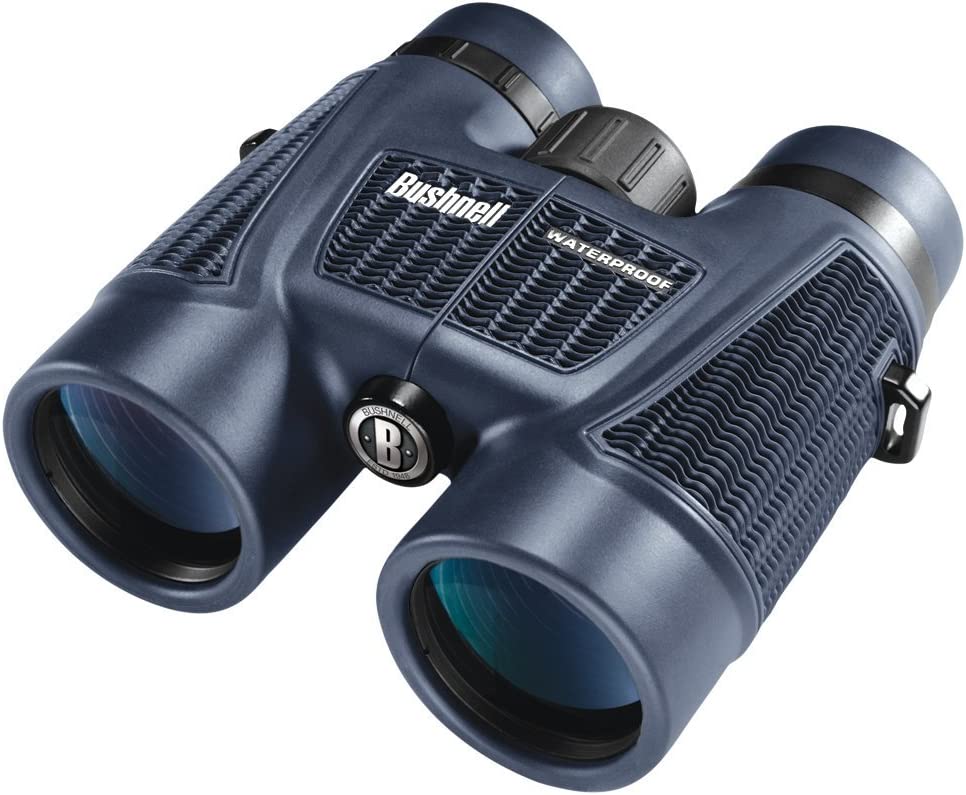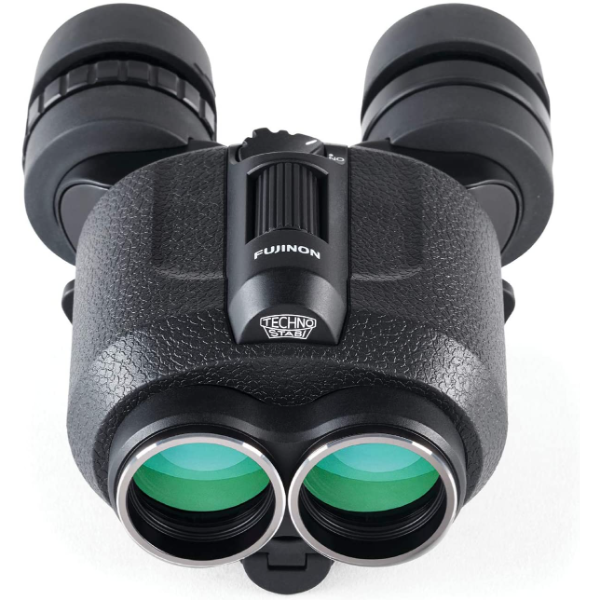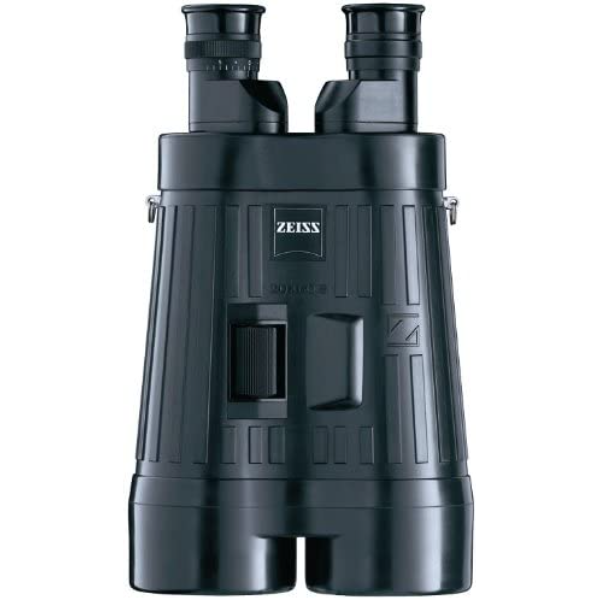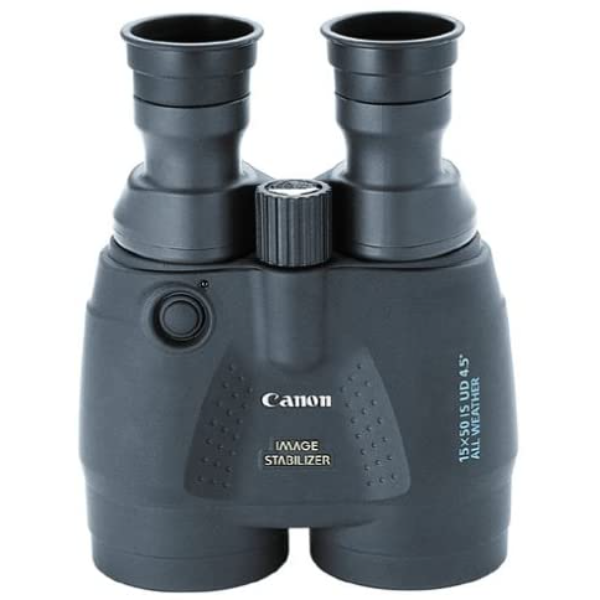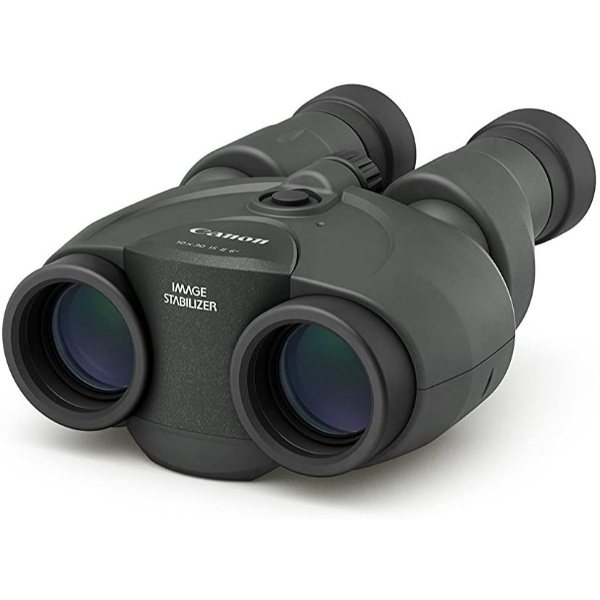
- Compact, Lightweight (8 oz. in total), and portable
- Good eye relief (14.5mm O.D.)
- Doublet field-flattener technology
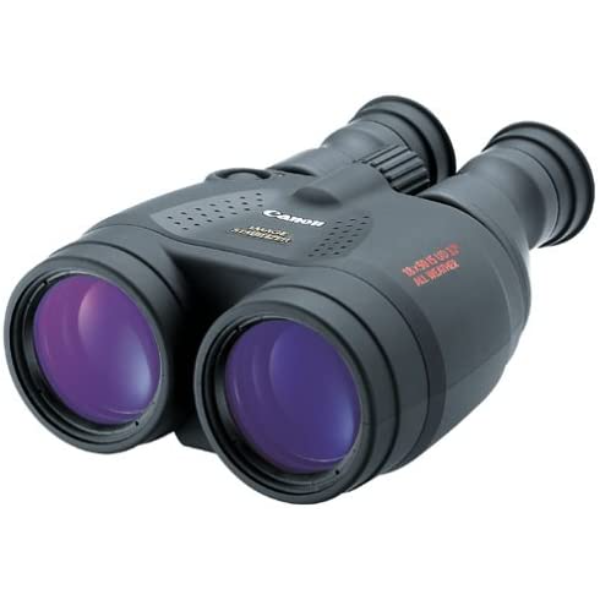
- Has an IPX4 rating, which is best for average rain, snow, and fog
- Wide field of view
- Shockproof and waterproof with 18x magnification
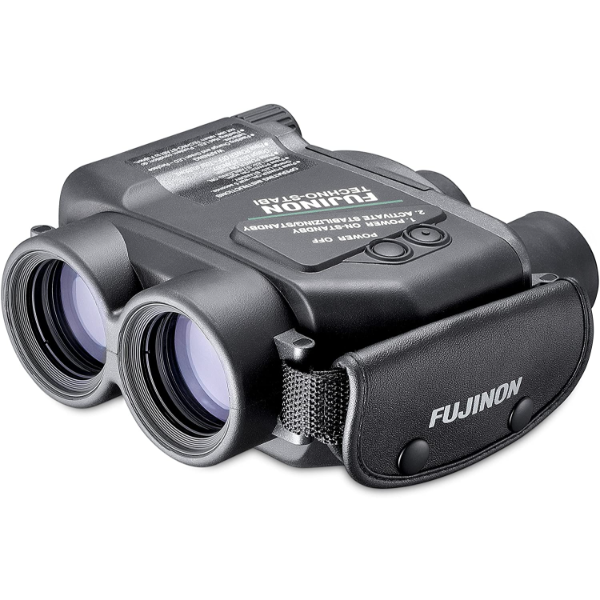
- 5 Degrees of stabilization
- 4 × AA type Batteries (alkaline)
- IR cut filter for bright night viewing
We all love to get out and explore the world, but nothing will ruin a backpacking trip or day of birdwatching faster than a shaky image from your binoculars. Canon image-stabilized binoculars are designed to eliminate the shakes that come from trying to hand-hold such long, heavy camera lenses and can make your experience more enjoyable for all involved.
Therefore, it makes sense that image-stabilized binoculars are most commonly associated with long-distance sporting events, like bird and wildlife watching and big game hunting.
As we all know, heavy binoculars like to be planted on the ground when in use or placed against sturdy tree support, but it’s not always possible to find a safe place to rest your gear where you want it.
We have listed some image-stabilized binoculars below that we feel are great products, but first, let’s look at our top choices.
To make it to the top of our list of the best image-stabilized binoculars, every one of these products has to be able to keep up with all your demands on rain and shine.
Quick Summary: Top 7 Image Stabilized Binoculars
1. Canon 10×30 Image Stabilization II Binoculars
- Product Dimensions: 5.9 x 5 x 2.8 inches
- Color: Black
- Weight: 1.32 pounds
- Magnification: 10X
More features: Good eye relief (14.5mm O.D.), Compact, Lightweight (8 oz. in total), and portable, Doublet field-flattener technology.
Canon 10×30 Image Stabilization II Binoculars manufactured using Canon’s advanced optical technology are compact, highly portable binoculars that are ideal for birdwatching, travel, sports, and more.
Its advanced stabilization system, equivalent to an EF lens, makes these binoculars ideal for birdwatching, scenery, travel, etc. The large lenses and high magnification ratio combine to provide clear views of small subjects from up to 1000 yards away.
Porro prisms help provide outstanding image resolution and minimal loss of light. At the same time, the 10x high magnification ratio with a 30mm 1.18 in. objective lens effectively delivers images of 500 line pairs per mm on the diagonal and a field-flattened image with sharper detail from edge-to-edge.
More eye relief of 14.5mm 0.57 in. is provided for comfortable viewing. Lead-free glass means that Canon 10×30 Image Stabilization II Binoculars can enjoy a clear view without the image being compromised by impurities. With a bodyweight of only eight oz., these binoculars are among the lightest in their class.
This product includes a neoprene pouch, lens caps, lens hood, shoulder strap, and neck strap for easy portability and protection when not in use.
Pros
Cons
2. Canon 18×50 Image Stabilization Binoculars
- Product Dimensions: 11 x 8 x 5 inches
- Color: Black
- Weight: 2.6 pounds
- Magnification: 18X
- Eye Relief: 15mm
More features: Shockproof and waterproof with 18x magnification, Has an IPX4 rating, which is best for average rain, snow, and fog. Wide field of view.
Another binocular by Canon, the Image Stabilization All-Weather Binoculars, is another binocular by Canon. It is built to withstand all kinds of weather and elements with a magnesium alloy body and rubber armor surrounding it.
Another feature is its 18x magnification, which has the same specs as the other binoculars. However, based on personal experience, I recommend using these in open areas rather than forests because of their large size.
With the broad field of view, you’ll see a larger area in a shorter amount of time. The lenses are multi-coated for contrast, clarity, and color fidelity, and the Image Stabilization All-Weather Binoculars are shockproof and waterproof.
Overall, the Image Stabilization All-Weather Binoculars are an excellent option for birding, hunting, or general use.
Pros
Cons
3. Fujinon Techno Stabi TS1440-14×40 Binocular
- Product Dimensions: 9.71 x 13.03 x 6 inches
- Color: Black
- Weight: 4 pounds
- Magnification: 14X
More features: 5 Degrees of stabilization, 4 × AA type Batteries (alkaline), IR cut filter for bright night viewing.
Fujinon’s Techno Stabi binoculars are one of the lightest binoculars globally and are shockproof, rainproof, and mist-resistant.
It is also made out of fiberglass-reinforced, high durability plastic, making it weather resistant and suitable for all weather conditions. It also has phase-coated roof prism lenses, which deliver natural colors, vivid clarity, brightness, and resolution.
The phase coating technology helps reduce flare and ghosting, which results in crisp, clear images in all lighting conditions.
The alkaline batteries are four × AA size and weigh about 1.5 lb, which is convenient if you carry them all day.
The binoculars’ body is rubber armored, which gives it a firm grip, and users have a significant amount of control over the focus. This makes it easy to use and will not slip out your hands even with sweaty palms.
Five degrees of stabilization will allow you to view wildlife without the chance of blurry images.
Pros
Cons
4. Fujinon Techno-Stabi 16X28 Binoculars
- Product Dimensions: 4.72 x 2.91 x 5.94 inches
- Color: Black
- Weight: 1.12 Pounds
- Magnification: 16X
More features: Magnetic compass, Rubber armored body makes it last longer, Phase-coated lenses deliver natural colors, vivid clarity, and brightness.
Fujinon techno stabi ts16x28 binoculars are a durable and great pairing of magnification and clarity at a reasonable price.
The 8×40 polar vision that they offer will provide you with a good amount of side vision, which makes it easy to see the scenery or anything else that you want to look at.
The rubber-armored body is what makes this binocular stand out from the rest. It is designed with a vibration canceler, which is a technology that eliminates swaying of the view while you are using it.
This technology makes it so that you can use the binoculars fully and not worry about the image shifting while you are using them.
Fujinon’s Techno Stabis has an excellent bang for your buck and offers some of the best optical quality in its price range.
Pros
Cons
5. Zeiss Carl Optical 20×60 Image Stabilization Binocular
- Product Dimensions: 6.33 x 6.33 x 10.8 inches
- Color: Black
- Weight: 58.55 Ounces
- Magnification: 20X
More features: Optically coated lenses, The rubber-armored body gives it a good grip and makes it durable, comes with a carrying case.
Zeiss, a recognized brand of binoculars, produced Carl Optical 20×60 binoculars. The Carl Optical 20×60 binoculars are manufactured in Germany and produce an image as bright and clear as a full-sized telescope.
With 20x magnification, you will be able to view more of a distance and have a broader range of sight. With the image stabilizing gyro, you won’t worry about it shaking or shifting during use.
The two-piece multi-coated lenses are surrounded by rubber armor, giving it a firm grip. The lenses are also made in one piece and coated with premium grade coatings which help deliver crystal clear images.
They also feature phase coating technology which reduces ghosting, glare, and flare that would otherwise distort the image.
Zeiss image stabilization binoculars arrive with a rugged carrying case, which will allow you to bring them wherever you need to go.
Pros
Cons
6. Canon 15×50 Image Stabilization Binoculars
- Product Dimensions: 11 x 8 x 5 inches
- Color: Black
- Weight: 2.6 pounds
- Magnification: 20X
- Eye Relief: 15mm
More features: Multi-coated lenses with low dispersion glass, 5 Step compensation for handshaking, vibration, and thermal compensation, Waterproof and fog proof.
Canon 15×50 Image Stabilization binoculars are an impressive pair of binoculars with a 15x magnification ratio and a 50mm objective lens.
These canon binoculars are designed with a stabilizing image feature that reduces mirage and distortions that can affect the image. This image stabilizer will allow you to use binoculars with minimal degradation of the images.
You can also use the 5-step compensation for handshaking and vibration compensation when taking photos or videos.
With its multi-coated lenses, it’s able to deliver high contrast and crisp images and a wide field of view. It also delivers excellent color fidelity. The long eye relief feature will allow you to use binoculars without worrying about eye strain or discomfort.
Pros
Cons
7. Canon 12×36 Image Stabilization III Binoculars
- Product Dimensions: 0.04 x 0.04 x 0.04 inches
- Color: Black
- Weight: 1.46 pounds
- Magnification: 12X
More features: High magnification ratio, distortion-free images, Can be used for hunting, hiking, and other outdoor activities.
Here is another binocular from Canon designed to offer a high magnification ratio of 12x. These binoculars are designed with high-quality glass and offer a crisp and clear view.
It is one of the most popular binoculars on the market because of its lightweight and compact size and its excellent image stabilizer system, allowing you to use the binoculars for an extended period without worrying about shaking or distortion.
The superb image stabilization system will be helpful for those who enjoy watching sports or other activities. You can also use it for hunting, hiking, and other outdoor activities.
You will enjoy distortion-free images, which will help you get a clear and sharp image from the binoculars. You will be able to see the distance and enjoy the scenery with no problems.
Pros
Cons
Buying Guide :
You should consider several factors when buying a pair of binoculars, including magnification power, lens diameter, objective lens size, eye relief, field of view, and other features.
Let’s have a quick glimpse of these factors :
1. Which magnification is best?
With a magnification of 8x-10x, you can use it to spot and observe wildlife during the day. With higher magnification, like 15x – 20x, you can use it to watch sporting events and hunt at night.
The best magnification for astronomy is 8x-10x which is ideal for visualizing the stars. The best magnification for birdwatching is 15x-25x, which will allow you to see more detail in the bird.
Whereas, you need to buy a pair of binoculars with higher magnification for hunting and boating, better than 15x.
2. Active image stabilization:
These devices use lenses with a unique optical composition to reduce the effects of vibration and shake, not only to improve comfort but also to prolong the life of binoculars.
Therefore, you must thoroughly research how the binoculars can expect much image stabilization.
3. Passive image stabilization:
This image stabilization uses a mechanism to counteract the effects of vibration without using any lenses or diaphragms. The optics-based IS works by detecting waves in the viewport, which are then translated into electronic signals used to compensate for vibrations.
3. Pricing:
The cost of each pair of binoculars will vary depending on the manufacturer. You need to see if the binoculars are worth the price and if you are satisfied with their performance.
There’s no need to spend a fortune on a pair of binoculars. Make sure that you’re buying a quality product worth your money. We have categorized pricing into various price slots to find the right price for you.
Up to 500 dollars: For people who want to spend a budget on their binoculars, this price range can contain high magnification binoculars and compact, lightweight models.
500 to 2000 dollars: This price range can contain high-quality, compact, and lightweight binoculars.
Above 2000: This range can include premium binoculars like the 10×50 and 18×56, designed to deliver great value for money. Moreover, you can also find binoculars suitable for the long-range.
4. Field Of View:
Field of view (FOV) is nothing but the distance you can see with your naked eyes when you look through the binoculars. Usually, binoculars have between 65 and 75mm, which means that you can view 650m or 756 m when using a pair of binoculars.
5. Eye Relief :
Eye relief is the distance between your eye and the eyepiece. You need to adjust this distance according to the size of your eyes. For example, people with a big eye can have a more extended eye relief than those with relatively small eyes.
6. Weatherproofing:
You need to choose weatherproof binoculars. The binoculars should be able to sustain any harsh conditions such as rain, snow, moisture, and wind. Good quality binoculars will be fully sealed and can be used in rainy and foggy weather.
7. Dimension:
To get a firm grip, you need to make sure that the binoculars are compact. Some companies make use of unique designs that help provide high strength.
8. Weight:
You need to choose binoculars that are lightweight and compact for comfortable use. The weight is significant for people who want to travel or hunt in different weather conditions. You should also make sure that the weight is balanced.
Frequently Asked Questions:
1. Do you need image stabilization?
It’s always a good idea to buy binoculars with image stabilization features because in most outdoor activities, the binoculars usually shake a lot. Even if you bring your tripod, it will be challenging to stabilize shaky images.
Moreover, when taking images of wildlife at night or hunting in the wild, shaking can affect your ability to get clear and sharp images of the target.
2. Are image-stabilized binoculars worth it?
Image stabilization binoculars are worth their money and are a tremendous advantage for sports enthusiasts, hunters, and birdwatchers. You should not be discouraged from investing in these devices but instead realize that you need them to get the most quality images possible.
3. What does Image Stabilization do in binoculars?
Image stabilization using a de-magnifying lens will eliminate the shaking of images and help you get clear, sharp images.
4. Do binoculars have stabilization?
Image stabilized binocular is a new invention that most modern brands have added to their binoculars. These devices usually use a mechanism that allows users to see clear, sharp images from any angle.
5. How do you stabilize binoculars?
There are different ways to stabilize a binocular image. However, most binoculars today use image stabilization which means that the image will be stabilized every time you move the device.
6. What is your experience with Image Stabilization?
After researching and testing out several brands, we decided to use Swarovski binoculars that featured Image Stabilization technology. The images were perfectly stabilized, and we found them to be great quality products with an overall good value.
7. How can I tell if the image stabilizer is working?
One of the first signs that your image stabilizer is working is that it will provide you with an overall steady image. You can also check the movement by shaking the device back and forth. If there are still tremors and jerky movements, then you know that it’s time to try out a different set or brand.
Conclusion:
Finding the best image-stabilized binoculars can be quite a task to accomplish. The best way to buy this device is to do extensive research on the various brands available.
Do not hesitate to speak with your friends who are also using this product, and read as many reviews as possible before buying one.
The most important aspect of looking for suitable binoculars is getting a pair to fit your needs and preferences.




